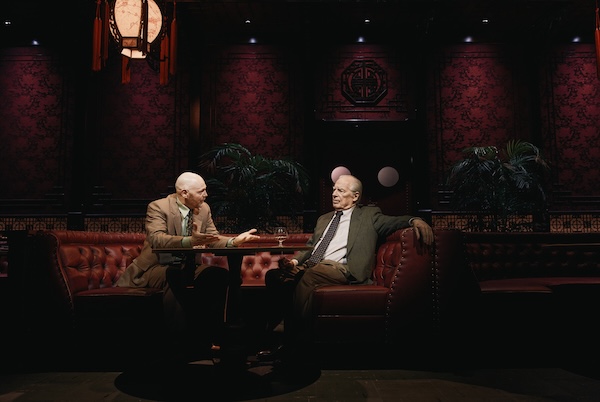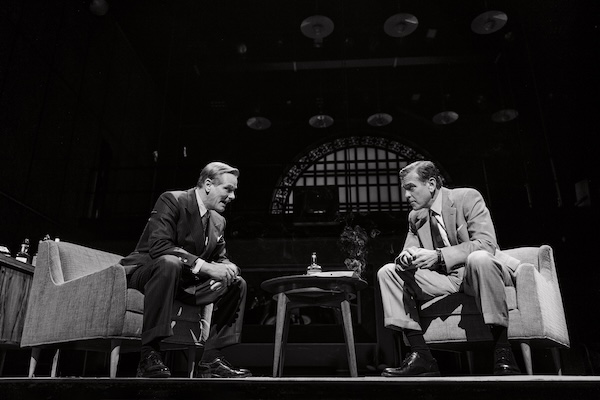Theater Commentary: Star-Driven Plays Are Raking It in on Broadway — “Glengarry Glen Ross,” “Good Night, and Good Luck”
By Christopher Caggiano
Prices for Broadway tickets are out of control. But that’s not stopping people from buying them — provided they get to see the right Hollywood stars.
On Broadway, it seems, no ticket price is too high. Even as our lunatic president seems dead set on driving our economy off a cliff, as anxiety looms large, and the headlines grow more dire by the day, Broadway grosses continue to defy gravity. At least when it comes to certain shows.
But it’s not the plays themselves that are drawing record-breaking crowds. It’s the names above the title. As long as there’s a major film or TV star on the stage — or two, or three — audiences seem eager to pay outrageous sums for the privilege of being in the room. Quality has become almost irrelevant. What matters is being able to say, “Oh, we saw the Clooney thing last night…” For that kind of cachet, the platinum cards are at the ready.
Consider the week ending March 30, 2025, which is when I saw Glengarry Glen Ross and Good Night, and Good Luck. The numbers are staggering:
Glengarry Glen Ross
Key names: Kieran Culkin, Bob Odenkirk, Bill Burr
Top ticket: $799
Average paid admission: $200.01
Weekly gross: $2.1 million
% of capacity: 101.57%
Good Night, and Good Luck
Key name: George Clooney
Top ticket: $775
Average paid admission: $298.83
Weekly gross: $3.3 million
% of capacity: 100.53%
I saw both productions as a critic, which means I didn’t pay for my tickets. And that’s the only reason I went. My seat for Glengarry Glen Ross would have cost me $602. For Good Night, and Good Luck, it would’ve been $849 — before fees. If I hadn’t been comped, I simply wouldn’t have gone. And after seeing both productions, I can say with confidence that I wouldn’t have missed much. And neither will you.
Meanwhile, another celebrity-laden production, Othello, which I wasn’t invited to and therefore didn’t see, posted similarly stellar numbers:
Othello
Key names: Jake Gyllenhaal, Denzel Washington
Top ticket: $897
Average paid admission: $378.73
Weekly gross: $3.16 million
% of capacity: 100.00%
I’ve seen Denzel Washington on stage. I’ve seen Jake Gyllenhaal on stage. I’ve seen Othello. Putting all three together doesn’t suddenly justify a $900 ticket. In contrast, lesser-known plays on Broadway without celebrity stars have recently been pulling in weekly grosses around $300,000. That’s not a small gap. It’s a chasm, not unlike the larger one that our unfortunate president seems hell-bent on intensifying between the rich and the poor in our country.
But back to Broadway. The sad thing is that it isn’t really about the work onstage anymore. It’s about access — who can afford these tickets, and who gets to claim they were part of something exclusive. Broadway has always had a bit of that country club vibe, but what we’re seeing now is the theater-as-luxury-good trend hitting its illogical extreme. And if the right names are attached, people seem happy to pay whatever it takes — even if the reviews are lukewarm and the productions underwhelming.
Glengarry Glen Ross

Kieran Culkin and Bob Odenkirk in Glengarry Glen Ross. Photo: Emilio Madrid
Glengarry Glen Ross is David Mamet’s 1984 Pulitzer Prize–winning play about a group of desperate real estate salesmen willing to lie, cheat, and betray one another to survive in a cutthroat office. It’s a harsh, testosterone-heavy meditation on masculinity, capitalism, and failure.
But since people are paying to see stars, let’s talk about the stars. Kieran Culkin plays top salesman Richard Roma with a kind of frantic energy that never quite lands. Rather than coming across as slick, charming, or dangerous — the traits that make Roma effective — Culkin often seems like a child having a tantrum. The character’s edge is gone, replaced by something thinner and less believable.
Bob Odenkirk’s Shelly Levene doesn’t fare much better. His performance feels labored, and it’s difficult to track any evolution between the desperate Levene of the first act and the broken man in the second. The tone remains flat throughout, making the arc feel more like a plateau. Michael McKean’s George Aaronow, meanwhile, is more listless than layered. What should be a portrait of faded resilience comes off as sleepy and unfocused — less a once-proud fighter brought low, more a man who never had much fight to begin with.
The surprise here is Bill Burr. I’m not a fan of Burr’s comedy — I find his persona grating — but there’s no denying that here Burr delivers the most effective performance in the cast. His Dave Moss is angry, sharp, and alive in a way few others onstage manage to be. He nearly steals the show — no small feat when he’s sharing the stage with actors who are supposedly more seasoned.

Bill Burr and Michael McKean in Glengarry Glen Ross. Photo: Emilio Madrid
As for the nonstars, Donald Webber Jr., playing office manager John Williamson, offers one of the few performances in the show with an internal rhythm and a discernible arc. His quiet restraint and deliberate pacing make the character feel grounded in reality — a stark contrast to the vagueness around him.
The direction is part of the problem. Under the guidance of Patrick Marber, the production never really crackles. The energy is slack, the transitions are uneven, and the tone shifts feel arbitrary rather than deliberate. While the show has a slick exterior — glossy, well-lit, and filled with familiar faces — it never digs beneath the surface. This is a Mamet play without teeth.
And then there’s the audience. Sitting in the resplendent Palace Theatre, a cavernous space ill-suited to the intimacy of Mamet’s writing, the production felt less like a night at the theater and more like a luxury lifestyle event. Seth Meyers was sitting behind me, and the people around me seemed more intent on gawking and trying to get a selfie with Meyers in the background than in engaging with what was onstage. It all had the air of a self-satisfied orgy of celebrity worship. The play, frankly, seemed beside the point.
Good Night, and Good Luck

Glenn Fleshler and George Clooney in Good Night, and Good Luck. Photo: Emilio Madrid
If audiences are content to pay for star presence alone, Good Night, and Good Luck offers a marquee opportunity. George Clooney’s name is above the title, and that seems to be enough. What’s onstage, however, is another matter entirely.
Good Night, and Good Luck follows journalist Edward R. Murrow and his CBS News team in the 1950s as they confront Senator Joseph McCarthy’s anti-Communist crusade. (Geez, remember when conservatives hated Russia?) The story centers on Murrow’s efforts to expose McCarthy’s tactics at a time when fear and political pressure threatened to silence dissent.
The production is disjointed, filled with gestures toward significance but lacking much dramatic cohesion. It opens with a nightclub singer performing “When I Fall in Love” — the entire song — a strange, indulgent choice that never ties back into the story. The jazz band remains onstage throughout, with songs covering scene transitions, but the music never seems integrated into the storytelling. It’s all mood, no meaning.
Other plot points feel just as untethered. A subplot about two married characters hiding their relationship from the newsroom is introduced but never explored or resolved. A character’s suicide is dropped in late in the show with barely any buildup and no emotional aftermath. The moments don’t resonate because the play hasn’t earned them. They feel like arbitrary dramatic beats inserted to give the illusion of weight.
The direction by David Cromer does little to clarify or sharpen the experience. Scenes lack shape and momentum. Emotional beats don’t build — they just arrive and recede. For a play about moral conviction in the face of authoritarianism, the stakes feel strangely low throughout. The staging is so unfocused that it’s often unclear where you’re even supposed to be looking at any given time.

Paul Gross and George Clooney in Good Night, and Good Luck. Photo: Emilio Madrid
George Clooney, in his Broadway debut as Murrow, spends much of the play appearing as if he’s reading from a teleprompter — which works when Murrow is delivering a news broadcast, but not when he’s supposed to be in a private moment. There’s a sameness to his delivery that keeps the character at arm’s length.
Another major problem is that the play, adapted from the film Clooney co-wrote and directed, leans heavily on archival footage. It felt like we spent a full half hour just watching newsreels. The Murrow-McCarthy showdown — not to mention the famous “Have you no decency, sir?” confrontation — is shown via actual footage instead of being dramatized, which gives the material historical weight but strips it of theatrical energy.
Clooney seems to believe this is a vital play for our moment — a reminder of the power of a free press — but instead of trusting the audience to make that connection, he spells it out with a final video montage of momentous events that stretch from the ’50s to the present day, culminating with Elon Musk aping the Nazi salute. The play feels less like a dramatic work and more like a civics lesson with production values.
The takeaway — that the press can bring down tyrants — might be timely, but in Clooney’s hands it comes across as glib. Without the emotional and dramatic groundwork to support it, the idea doesn’t land. It just floats by, like much of this show.
Broadway has always been expensive, but with ticket prices now pushing uncomfortably past $800, it seems that we have officially reached the point of insanity. The fact that these productions are mediocre seems beside the point. People aren’t paying for entertainment: they’re paying to breathe the same air as Hollywood royalty. It seems that, provided that rich and influential people continue to value the cultural currency of “I was there,” the grosses will continue to be enormous. And yet the theater, somehow, feels smaller for it.
Christopher Caggiano is a freelance writer and editor living in Stamford, CT. He has written about theater for a variety of outlets, including TheaterMania.com, American Theatre, and Dramatics magazine. He also taught musical-theater history for 16 years and is working on numerous book projects based on his research.

Nice work!
Thanks much.